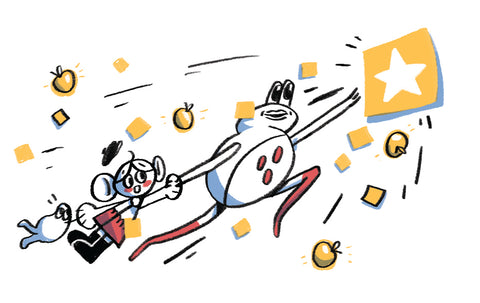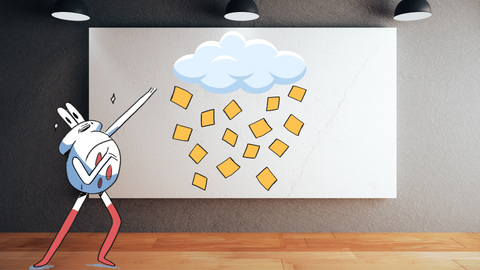This is a live-session write-up with a bit of a difference! As the event was all about participation, there were breakouts galore - so we’ve written up all the good stuff and included video clips of the best stuff, rather than including the full recording.
This session was facilitated by Meg Bolger of Facilitator Cards. Meg introduces herself as a pro facilitator and facilitation geek. This session is a masterclass in getting people involved - in fact, this write-up is a bit ‘meta’ in that it focuses as much on the skills Meg used as the conversations that were had. Intros out of the way - let’s dive in!
Unsurprisingly for a participation workshop, the icebreaker question about what people love to geek out about had a lot of input! And what a weird bunch you all are (in the kindest possible way):
- Bodybuilding
- Neuroscience
- Pomodoro
- Golf
- Mexican food
- Volleyball
- Fermentation
- Sky running
- Tiny chihuahuas
Tip 1: warm up with cameras to encourage their use!
Meg used a novel warm-up technique called ‘Peekaboo’. All you have to do is cover your camera, and then as the facilitator makes statements, participants take their finger off the camera if it applies to them. One of the statements was very telling:
“I have been to an online session with breakout rooms and dropped out so that I did not have to join in.”
And yes, most people took their thumbs off their cameras for that one.
It was absolutely fine for anyone who didn’t want to take part to keep their camera off, too - remember, not everyone can or wants to be visible! Mention allowances like that up front to help everyone feel comfortable.
Tip 2: give people the prep time they need to succeed
One great thing about this session is the way that Meg cued up two questions and gave everyone a couple of mins to consider their answers. Then, she dropped people into teeny breakout rooms of just two people to discuss their thoughts. That means no one was put on the spot - everyone had time to think about things before speaking about them. Remember that trick and try it yourself! The questions were:
What is the goal of participation? Why is it important for people to participate?
And here’s what they learned, summed up very neatly by attendee Alison based on her breakout chat with Barry.
To summarise: Nobody wants to be talked at. The attendees are the experts, not the facilitators - participation makes meetings more interesting and exciting and creates a safe space for those experts to share their knowledge.
Participation also:
- Helps with buy in
- Creates more diverse ideas
- Gives a sense of belonging/ownership
- Encourages people to digest and remember the materials
- Helps people get their voices heard - they’re in that room for a reason! And many of them are also expensive resources. Their voice could be crucial, and you’ll miss out if they are quiet, or if someone else is too loud.
Tip 3: make use of the chat function to encourage diverse answers
In the video below, Meg asks everyone to answer a couple of questions about how to discourage participation:
- What is a big, obvious way you can discourage people from participating in your Zoom workshop or meeting?
- What are some smaller, subtle ways you could discourage participation (for example, without coming out and telling people you don’t want them to join in)?
By getting people to write their answers but not send them until she gives the signal, Meg gets a variety of answers even though they come in via chat (which is otherwise notorious for creating reams of the same answer on repeat!). It also keeps the answers grouped in a way that allows people to revisit them later without having to pick through bits of chatter. What a neat trick.
Tip 4: work backwards, it’s more fun
You’ll see the ‘Opposite thinking’ label at the top of the virtual participation card on her screen. That's why Meg was asking people how to discourage participation... sometimes, working out how to achieve something is best done by working out all the ways of preventing it (similar to the Reverse Brainstorm workshop tactic).
The questions above are much more fun to answer - how can you STOP people from doing what you want them to?
The groups then get split into new breakout rooms to discuss the two lists of answers to the questions above. Again - they get a couple of minutes to read through the list and percolate ideas on their own, first.
Breakout discussions: what can we learn from that list?
We'll level with you, the breakout session could have gone a little better - and here’s why.
Meg gave bad instructions on purpose.
(And can we just shout out that this is a fantastic Storyteller Tactic, too - own up to breaking a rule and people will hang off your every word. She's good!)
Watch the video for a bit more detail, but following a brief chat, here are the things the group wishes Meg had done to help ensure their success.
- Use a less vague question
- Tell them how much time they will have and how many other people will be there
- Remind them of what they need to return to the main room with
- Ensure the tech works the same for everyone so they can all access everything
- Suggest a way of choosing who should kick things off (e.g., go in alphabetical order, or whoever’s birthday is next)
Meg's take: We are creating containers for people to participate inside of. “Do this, here, for this long”. Good containers need boundaries, like how much time you have, what the focus is and what you need to produce by the end of it. Those boundaries also make you feel more relaxed and less awkward and uncertain. You know what's expected of you and feel empowered to deliver it Perfect conditions for participation!
Tip 5: your attendees are the experts, give them the spotlight
Next up, Meg asked for some volunteers to have a small group chat… in front of the rest of the group. It sounds like quite a tall order! Watch the video to see how they get on (hint: they nailed it).
Like this approach? It's called a Fishbowl Discussion.
Here are the key takeaways from their discussion of the subtle ways to deter people from participating:
- Not giving time for the awkward silence to fade away: filling the silence leaves no spaces for participants!
- Passive aggression and a lack of respect - this shuts down conversations and prevents people from even wanting to participate.
- Sometimes, facilitators lack the confidence to let other people take the limelight, and to encourage them through their nerves.
- No one has ever benefited from being told they’re almost out of time… and yet, facilitators often end up transferring their own anxiety about that happening to others in the group!
- Asking people to participate by giving answers and then not acknowledging those answers does not reinforce the behaviour. Ignoring input is a punishment (in dog training - Eve’s speciality!) and positive feedback is very important to people, too. Get in and reinforce behaviour (and quickly) to encourage more of it.
And if you’re wondering, they did get a round of applause for taking part!
Finally, Meg opened up the chat feature and asked people to use it to brainstorm answers to the question: what’s one thing that encouraged your participation in this session? All of these answers are like additional tips to add to the five big ones we’ve discussed already - although we don’t think you can bottle "Meg’s warmth and energy" (sorry). You can, however, copy her approach to organisation (see after the list for more).
- The people
- Nice small breakout rooms
- The ability to participate in chat
- The warm-up encouraging camera use
- Meg’s energy/warmth
- New ways to engage (peekaboo!)
- The willingness of the other participants to be vulnerable
- The informal, open atmosphere
- How well planned everything was
Which leads us nicely onto Meg’s explainer about how she planned the session using Facilitator Cards, which you can see in the video below!
These cards are used with wet-erase markers, so you can plan your agenda, use the cards, then give them a dunk and a wipe and they’re ready for next time. Huge thanks to Meg for a masterclass in getting people to participate - and to everyone who attended and took part.
PS: if you’d like to bring text boxes up on screen during Zoom calls, like Meg did during the session, she recommended trying OBS Project or Mmhmm.








